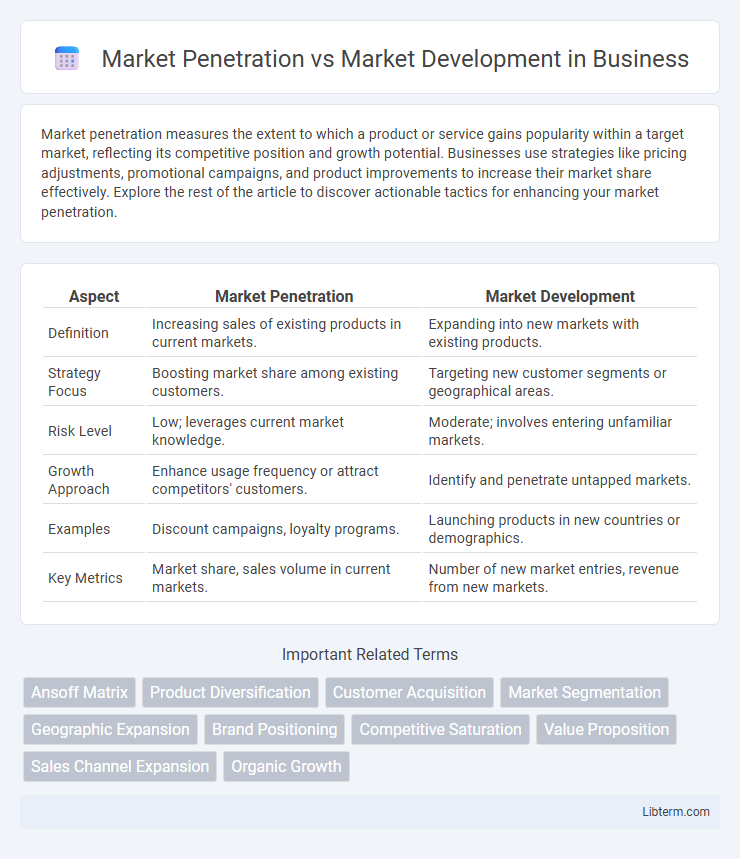Market penetration measures the extent to which a product or service gains popularity within a target market, reflecting its competitive position and growth potential. Businesses use strategies like pricing adjustments, promotional campaigns, and product improvements to increase their market share effectively. Explore the rest of the article to discover actionable tactics for enhancing your market penetration.
Table of Comparison
| Aspect | Market Penetration | Market Development |
|---|---|---|
| Definition | Increasing sales of existing products in current markets. | Expanding into new markets with existing products. |
| Strategy Focus | Boosting market share among existing customers. | Targeting new customer segments or geographical areas. |
| Risk Level | Low; leverages current market knowledge. | Moderate; involves entering unfamiliar markets. |
| Growth Approach | Enhance usage frequency or attract competitors' customers. | Identify and penetrate untapped markets. |
| Examples | Discount campaigns, loyalty programs. | Launching products in new countries or demographics. |
| Key Metrics | Market share, sales volume in current markets. | Number of new market entries, revenue from new markets. |
Introduction to Market Penetration and Market Development
Market penetration focuses on increasing sales of existing products within current markets by enhancing customer usage, attracting competitors' customers, or converting non-users. Market development involves expanding into new geographic areas or demographic segments with existing products to capture additional market share. Both strategies aim to drive growth but target different market scopes and customer bases for business expansion.
Defining Market Penetration
Market penetration refers to the strategy aimed at increasing the market share of existing products or services within current markets by attracting more customers or enhancing usage. It involves tactics such as competitive pricing, advertising, promotional campaigns, and improving distribution channels to boost sales volume. Companies measure market penetration by analyzing sales growth, customer acquisition rates, and market share percentage in targeted segments.
Defining Market Development
Market development refers to the strategic approach of expanding a company's reach by targeting new customer segments or geographic areas with existing products or services. It involves identifying untapped markets and tailoring marketing efforts to attract these new audiences, ultimately increasing sales without altering the core product. Unlike market penetration, which deepens presence in existing markets, market development prioritizes growth through market diversification and exploration.
Key Differences Between Market Penetration and Market Development
Market penetration focuses on increasing sales of existing products within current markets by enhancing market share through strategies such as pricing adjustments, promotions, and improved distribution channels. Market development involves expanding into new geographic regions or targeting different customer segments with existing products to unlock new revenue sources. The key difference lies in market penetration deepening presence in established markets, while market development seeks growth by entering previously untapped markets.
Strategies for Successful Market Penetration
Successful market penetration strategies focus on increasing product usage among existing customers and attracting competitors' buyers through competitive pricing and aggressive marketing campaigns. Businesses enhance market share by optimizing distribution channels, leveraging customer loyalty programs, and improving product availability and visibility. Emphasizing targeted advertising, promotional offers, and continuous innovation ensures sustained growth within current markets without expanding into new demographics.
Strategies for Effective Market Development
Effective market development strategies involve identifying and targeting new customer segments or geographic regions with tailored marketing approaches and product adaptations. Leveraging market research to understand unmet needs and local preferences enables businesses to customize offerings and communication, increasing the chances of successful entry. Strategic partnerships and distribution channel expansion also play crucial roles in accelerating market development and building brand presence in untapped markets.
Benefits and Risks of Market Penetration
Market penetration offers benefits such as increased market share, stronger brand loyalty, and higher sales volume by targeting existing customers with current products, often resulting in lower marketing costs and faster returns on investment. Risks include market saturation, intensified competition, and limited growth potential if the existing market becomes fully exploited or customers' needs evolve. Companies must balance aggressive penetration strategies with innovation to avoid customer fatigue and declining profit margins.
Benefits and Risks of Market Development
Market development offers the benefit of expanding a company's customer base by entering new geographic regions or market segments, leading to increased revenue potential and diversification of market risks. However, risks include significant costs related to market research, localization, and regulatory compliance, as well as the uncertainty of consumer acceptance in unfamiliar markets. Companies must carefully evaluate competitive dynamics and cultural differences to mitigate the risks associated with market development strategies.
When to Choose Market Penetration vs Market Development
Choose market penetration when your current market shows potential for increased sales through deeper customer engagement, pricing strategies, or enhanced promotions within existing segments. Opt for market development when product adaptation or targeting new geographic areas, demographics, or customer segments offers more growth opportunities beyond current markets. Analyzing market saturation, competitive intensity, and resource capabilities helps determine the optimal approach between market penetration and market development.
Case Studies: Market Penetration and Market Development in Practice
Case studies in market penetration often highlight companies like Starbucks, which increased sales by intensifying marketing efforts and expanding store locations within existing markets. Market development examples include Netflix's entry into international markets, adapting content and marketing strategies to attract new customer segments abroad. These contrasting strategies demonstrate how leveraging existing products in current markets contrasts with introducing products to new geographic or demographic areas for growth.
Market Penetration Infographic

 libterm.com
libterm.com